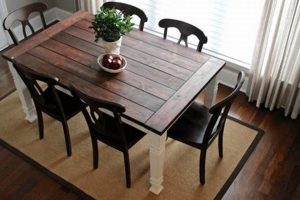A self-constructed station designed for processing freshly caught fish offers a practical solution for anglers. Typically, these structures provide a dedicated surface for scaling, gutting, and filleting, minimizing mess and streamlining the fish preparation procedure. They can range from simple, repurposed surfaces to elaborate, purpose-built installations incorporating features such as running water, storage, and integrated waste disposal systems.
The advantages of having a dedicated fish processing area are considerable. It centralizes the often messy and odorous activity, keeping it away from food preparation areas and other sensitive zones. Such a setup can significantly improve hygiene and reduce the risk of cross-contamination. Historically, anglers have always sought methods to efficiently prepare their catch, with makeshift tables or shoreline rocks commonly serving as rudimentary processing areas. The modern iteration represents a more refined and organized approach.
The remainder of this article will address essential considerations for building an effective station, including material selection, design considerations, essential tools, and safety precautions. Guidance will be provided to assist in the construction of a functional and durable setup for years of angling enjoyment.
Construction Insights
The following are practical guidelines for constructing a functional and durable station, intended to enhance the fish processing experience.
Tip 1: Material Selection. Opt for materials resistant to moisture and bacterial growth. High-density polyethylene (HDPE) is an excellent choice for the work surface due to its durability, ease of cleaning, and resistance to chemicals. Pressure-treated lumber is suitable for the frame, providing structural integrity in outdoor environments.
Tip 2: Plumbing Integration. If incorporating running water, utilize PVC piping for its affordability and ease of installation. Ensure proper drainage to prevent stagnant water and odor buildup. A dedicated drain line connected to a suitable disposal system is crucial for maintaining hygiene.
Tip 3: Surface Design. Implement a sloped surface to facilitate efficient water runoff. Raised edges around the perimeter prevent spills and contain debris. Consider incorporating a measuring scale or markings directly onto the surface for accurately assessing fish size.
Tip 4: Tool Organization. Install knife holders, storage compartments, or hooks to keep essential tools readily accessible and organized. This promotes efficiency and prevents potential accidents caused by misplaced sharp objects.
Tip 5: Waste Management. Integrate a dedicated waste receptacle, ideally with a lid, to contain fish waste and minimize odors. Regularly empty the receptacle to prevent the accumulation of bacteria and pests.
Tip 6: Stability and Support. Ensure the structure is stable and level to prevent tipping or wobbling during use. Reinforce joints and connections to withstand the weight of fish, tools, and water.
Tip 7: Ergonomic Considerations. Design the height of the surface to allow for comfortable standing posture, minimizing strain on the back and shoulders during extended use.
Implementing these recommendations will lead to a long-lasting and functional space that will offer efficient fish processing. Careful planning and execution are essential for a structure that meets the specific needs and preferences of the angler.
The article’s concluding section will summarize essential maintenance practices, ensuring the longevity and hygienic operation of the constructed station.
1. Surface Material
The selection of surface material is a critical determinant in the functionality and longevity of a self-constructed fish cleaning station. The material directly impacts ease of cleaning, resistance to environmental factors, and overall hygiene, making it a foundational element of the entire structure.
- Hygiene and Cleanability
The surface must be non-porous and easily sanitized to prevent bacterial growth and cross-contamination. Smooth, non-reactive materials such as high-density polyethylene (HDPE) or certain types of stainless steel are preferable. Examples include commercially available cutting boards used in food preparation, adapted for larger-scale fish processing. These materials resist the absorption of odors and are readily cleaned with standard sanitizing agents.
- Durability and Weather Resistance
Outdoor fish cleaning stations are exposed to the elements, requiring materials resistant to water damage, UV degradation, and temperature fluctuations. Marine-grade polymers and treated lumber provide adequate protection. For instance, a surface constructed from reclaimed boat decking offers a sustainable and durable option. The material’s resistance to warping and cracking ensures long-term structural integrity.
- Chemical Resistance
The surface will inevitably come into contact with fish scales, blood, and cleaning agents. Materials must resist degradation from these substances to prevent discoloration, staining, and weakening. Epoxy resin countertops, commonly used in laboratories, exemplify chemical resistance and provide a seamless, easily cleaned surface. Selecting a material incompatible with common cleaning agents may result in premature deterioration.
- Workability and Cost
While high-end materials offer superior performance, budget constraints may necessitate compromises. Plywood sealed with multiple coats of polyurethane provides a cost-effective alternative, though it requires more frequent maintenance. Considerations include ease of cutting, shaping, and attaching to the frame. A balance between cost, performance, and ease of construction is essential when selecting surface material for a fish cleaning station.
The interconnectedness of these facets underscores the importance of a well-considered surface material choice. The optimal selection contributes directly to the functionality, durability, and hygiene of the entire unit, ultimately enhancing the fish processing experience.
2. Frame Durability
The structural integrity of a self-constructed fish cleaning station is paramount. Frame durability dictates the longevity, stability, and safety of the entire unit, influencing its ability to withstand the rigors of regular use and environmental exposure.
- Material Selection and Resistance to Decay
The choice of framing material directly affects the structure’s resistance to rot, insect infestation, and corrosion. Pressure-treated lumber is a common and cost-effective option, offering protection against fungal decay and insect damage. Metal frames, particularly those constructed from aluminum or stainless steel, provide superior corrosion resistance, especially in saltwater environments. The selection process should consider the intended location and expected environmental conditions to mitigate potential degradation.
- Joint Construction and Load-Bearing Capacity
The method of joining frame components significantly impacts the overall strength and stability of the structure. Properly executed mortise-and-tenon joints, reinforced with weatherproof adhesive, provide exceptional strength and resistance to racking. Metal frames benefit from welded joints, ensuring a seamless and durable connection. The frame must be engineered to support the weight of the surface material, the fish being processed, and any additional equipment or supplies stored on or near the station. Insufficient load-bearing capacity can lead to structural failure and potential injury.
- Bracing and Stabilization Techniques
Diagonal bracing and cross-members enhance the rigidity of the frame, preventing swaying and wobbling during use. These structural elements distribute weight evenly and reduce stress on individual joints. For example, adding a lower shelf between the legs of the station not only provides storage but also contributes to overall stability. The implementation of appropriate bracing techniques is crucial for maintaining a level and stable work surface, particularly on uneven terrain.
- Protection Against Environmental Factors
Regardless of the primary framing material, supplementary protection against environmental factors is essential. Applying a waterproof sealant or paint to wooden frames helps to prevent moisture penetration and rot. Metal frames can benefit from powder coating or galvanization to further enhance corrosion resistance. Regular inspection and maintenance, including the reapplication of protective coatings as needed, are crucial for extending the lifespan of the frame and ensuring its continued structural integrity.
These facets highlight the multifaceted nature of frame durability. A well-engineered and constructed frame serves as the foundation for a functional and safe fish cleaning station. Compromising on frame durability can lead to premature failure, rendering the entire unit unusable and potentially creating hazardous conditions.
3. Water Access
The integration of a reliable water source into a self-constructed fish cleaning station represents a significant enhancement to its functionality and hygiene. The availability of running water streamlines the cleaning process, facilitates efficient waste removal, and minimizes the risk of bacterial contamination, thereby contributing to a safer and more sanitary food preparation environment.
- Facilitating Efficient Cleaning
A readily available water supply allows for the rapid removal of fish scales, blood, and other debris during the processing of the catch. This constant flushing action prevents the buildup of organic matter, reducing the potential for unpleasant odors and the proliferation of bacteria. Examples include the use of a simple garden hose connection or a more elaborate plumbed-in system with adjustable spray nozzles. Efficient cleaning minimizes cross-contamination and ensures a cleaner final product.
- Enhancing Waste Removal
Water is essential for directing fish waste, such as guts and trimmings, towards a designated disposal system. The force of the water can be used to channel waste into a collection container or, in more sophisticated setups, directly into a grinder or macerator for easier disposal. This prevents the accumulation of waste on the work surface and simplifies the overall cleaning process. Proper waste removal is crucial for maintaining a hygienic environment and preventing the attraction of pests.
- Controlling Odor and Bacterial Growth
The regular flushing of the work surface with water helps to suppress odors associated with fish processing. Water also inhibits the growth of bacteria by removing organic matter and reducing the moisture levels that support microbial proliferation. Implementing a system that allows for the application of sanitizing solutions in conjunction with water further enhances the control of bacterial growth. A cleaner environment translates to a reduced risk of foodborne illness.
- Streamlining the Filleting Process
Water is invaluable during the filleting process, helping to keep the fish moist and the knife clean. A wet knife glides more smoothly through the fish, resulting in cleaner cuts and less tearing of the flesh. Rinsing the fillets immediately after cutting removes any remaining scales or blood, improving their appearance and extending their shelf life. A dedicated water source simplifies and enhances the filleting process, resulting in higher-quality fillets.
The integration of water access elevates a self-constructed fish cleaning station from a basic work surface to a comprehensive fish processing center. By facilitating efficient cleaning, enhancing waste removal, controlling odor and bacterial growth, and streamlining the filleting process, a dedicated water source significantly improves the overall functionality, hygiene, and convenience of the station, contributing to a more enjoyable and productive angling experience.
4. Waste Disposal
The responsible management of fish processing byproducts is an integral component of a functional and environmentally conscious self-constructed fish cleaning station. Effective waste disposal mitigates potential health hazards, minimizes environmental impact, and contributes to the overall cleanliness and usability of the workspace.
- Collection Receptacles and Containment
The initial step in managing fish waste involves the provision of dedicated receptacles for the containment of organic material. These containers should be durable, leak-proof, and ideally equipped with secure lids to prevent the escape of odors and the attraction of pests. Examples range from simple plastic bins to purpose-built containers with integrated drainage systems. Proper containment minimizes the risk of contamination and facilitates the subsequent stages of waste disposal.
- Grinding and Maceration Systems
For larger-scale fish processing operations, or in situations where direct disposal is problematic, the integration of grinding or maceration systems can significantly reduce the volume and facilitate the handling of fish waste. These systems break down organic material into smaller particles, making it easier to transport and dispose of. Examples include garbage disposals adapted for marine use and dedicated fish waste grinders. Grinding and maceration can streamline the disposal process and reduce the overall environmental impact.
- Composting and Rendering Options
Sustainable waste management practices may involve composting or rendering fish waste. Composting transforms organic material into a nutrient-rich soil amendment, while rendering converts waste into usable products such as animal feed or biofuel. These methods offer environmentally responsible alternatives to landfill disposal. The feasibility of composting or rendering depends on the scale of the operation, local regulations, and the availability of suitable processing facilities.
- Legal and Regulatory Compliance
The disposal of fish waste is subject to local, state, and federal regulations designed to protect water quality and prevent the spread of disease. Compliance with these regulations is essential for responsible operation. Examples include restrictions on the dumping of fish waste into waterways and requirements for proper disposal at designated facilities. Anglers and builders must be aware of and adhere to all applicable regulations to avoid penalties and minimize environmental impact.
The aforementioned aspects illustrate the multifaceted nature of fish waste disposal in relation to the design and use of a self-constructed cleaning area. A comprehensive approach, encompassing effective collection, volume reduction (if necessary), sustainable disposal options, and adherence to legal requirements, is essential for ensuring responsible and environmentally sound fish processing practices.
5. Tool Storage
The integration of dedicated tool storage within a self-constructed fish cleaning station significantly enhances efficiency and safety. The proximity of essential implements, such as knives, pliers, and sharpening steels, streamlines the processing workflow. Conversely, the absence of designated storage necessitates repeated trips to retrieve tools, disrupting the rhythm of the task and increasing the risk of accidents due to misplaced sharp objects. An example would be a simple magnetic knife strip mounted to the side of the station, providing immediate access to blades while maintaining a safe and organized workspace. This direct correlation between accessible tool storage and operational efficiency underscores its importance as a core component of the design.
Furthermore, appropriate storage solutions protect the tools themselves, prolonging their lifespan. Exposure to the elements, particularly moisture and saltwater, can cause corrosion and degradation. Enclosed cabinets or weatherproof boxes provide a secure and dry environment, preventing damage and ensuring the tools remain in optimal condition. A practical application is the use of a repurposed tackle box, securely mounted beneath the work surface, to house pliers, scales, and other smaller implements. This minimizes exposure to the environment and keeps everything readily accessible, reducing the need for frequent replacements and maintaining a safe workspace.
In summary, tool storage within the context of a fish cleaning area is more than an organizational convenience; it is a fundamental safety and efficiency consideration. By ensuring tools are readily accessible, protected from the elements, and stored safely, the integration of well-designed storage solutions contributes directly to a more productive and secure fish processing experience. Overlooking this element can result in wasted time, damaged equipment, and an elevated risk of accidents.
6. Height Comfort
Ergonomic design is a critical element in the construction of a self-built fish cleaning station. The height of the work surface directly impacts user comfort, reducing physical strain and promoting efficient processing of the catch. Optimal height considerations prevent fatigue and potential musculoskeletal injuries.
- Minimizing Back Strain
An improperly designed workstation height can lead to excessive bending or hunching, placing undue stress on the lower back. The ideal height allows the user to stand upright with a slight bend in the elbows while working. For example, a table designed for a six-foot individual would be unsuitable for a person five feet tall, potentially causing significant discomfort and long-term back problems. Correct height minimizes spinal compression and promotes proper posture.
- Reducing Shoulder and Neck Tension
A surface that is too high forces the user to raise their shoulders, leading to tension in the neck and upper back muscles. Conversely, a surface that is too low requires excessive downward reaching, straining the shoulder joint. The optimal height allows for natural arm movement without requiring excessive elevation or extension. This reduces the risk of developing repetitive strain injuries, ensuring sustained comfort during extended fish processing tasks.
- Promoting Efficient Workflow
Appropriate height allows for unrestricted arm movement and efficient transfer of fish and tools. When the surface height aligns with the users natural reach, the workflow becomes smoother and more fluid. For instance, a well-designed station allows for easy access to knives, cutting boards, and waste disposal containers, minimizing unnecessary movements and maximizing productivity. Efficient workflow translates to less time spent processing fish and more time enjoying the catch.
- Adjustability and Customization
Given the variability in user height, an adjustable workstation offers the greatest flexibility and comfort. This can be achieved through adjustable legs or the use of platforms. Consider a design incorporating telescoping legs that lock into place at various heights, accommodating multiple users or different tasks. This level of customization ensures optimal ergonomic support for a wide range of individuals, promoting both comfort and safety.
The various aspects of height consideration underscore the importance of tailoring the fish cleaning station to the users specific needs. Prioritizing ergonomic design not only enhances comfort but also promotes long-term physical well-being, enabling anglers to enjoy their hobby without unnecessary physical strain.
7. Cleanability
Cleanability is a fundamental design consideration for any self-constructed fish cleaning station. The inherent nature of fish processing generates organic waste, creating a breeding ground for bacteria and unpleasant odors. Therefore, the ease and effectiveness with which the structure can be cleaned directly influences its hygiene, longevity, and overall usability.
- Material Selection and Surface Properties
The choice of materials for the work surface and frame significantly impacts cleanability. Non-porous materials, such as high-density polyethylene (HDPE) or stainless steel, resist the absorption of fish oils and blood, simplifying the cleaning process. For example, a table constructed with a smooth HDPE surface can be easily wiped down with a disinfectant solution, whereas a porous wood surface may require more aggressive cleaning methods and still harbor bacteria. The selection of appropriate materials is paramount for maintaining a sanitary work environment.
- Design Features for Waste Management
The integration of features that facilitate waste removal contributes directly to cleanability. Sloped surfaces, for instance, allow for efficient water runoff, directing debris towards a designated drain. The inclusion of a built-in sink with running water provides a convenient means for rinsing and sanitizing the work surface. Furthermore, a removable cutting board simplifies the cleaning process by allowing for thorough washing and disinfection away from the main structure. Design elements that minimize the accumulation of waste enhance the overall hygiene of the station.
- Accessibility and Disassembly
The ability to easily access and disassemble components of the fish cleaning station promotes thorough cleaning. Removable parts, such as cutting boards, knife holders, and drain trays, can be individually washed and sanitized, ensuring that no areas are overlooked. For instance, a table with a hinged work surface allows for easy access to the frame underneath, facilitating the removal of accumulated debris. A design that prioritizes accessibility ensures that all surfaces can be effectively cleaned, preventing the buildup of bacteria and odors.
- Resistance to Cleaning Agents
The materials used in the construction of the fish cleaning station must be resistant to commonly used cleaning agents, such as bleach, detergents, and disinfectants. Prolonged exposure to harsh chemicals can degrade certain materials, leading to discoloration, cracking, or weakening. For example, a stainless steel surface is highly resistant to corrosion from cleaning agents, whereas a painted wood surface may require gentler cleaning methods to prevent damage. Selecting materials that can withstand frequent cleaning with a variety of agents ensures the long-term integrity and hygiene of the station.
In conclusion, the cleanability of a self-constructed fish cleaning station is a function of material selection, design features, accessibility, and resistance to cleaning agents. Prioritizing these factors during the construction process ensures a hygienic, durable, and user-friendly workspace, ultimately contributing to a safer and more enjoyable fish processing experience.
Frequently Asked Questions
The following addresses common inquiries regarding the design, construction, and maintenance of a fish cleaning station intended for personal construction.
Question 1: What are the primary materials recommended for a self-constructed fish cleaning table’s surface?
High-density polyethylene (HDPE) and certain grades of stainless steel are favored due to their non-porous nature, ease of cleaning, and resistance to bacterial growth. Treated lumber sealed with multiple coats of marine-grade polyurethane may serve as a cost-effective alternative, though it necessitates more frequent maintenance.
Question 2: Is plumbing integration a necessity for a functional self-constructed fish cleaning table?
While not strictly required, the integration of a water source significantly enhances functionality. Running water facilitates efficient cleaning, waste removal, and odor control. If plumbing is incorporated, PVC piping is a common and affordable choice.
Question 3: What are the key considerations for ensuring the stability of a self-constructed fish cleaning table?
Frame material selection, joint construction, and bracing techniques are critical. Pressure-treated lumber or metal frames (aluminum or stainless steel) are recommended. Properly executed joints, reinforced with weatherproof adhesive or welding, are essential. Diagonal bracing and cross-members enhance rigidity and prevent wobbling.
Question 4: How can the potential for unpleasant odors be minimized in a self-constructed fish cleaning table?
Regular cleaning with disinfectant solutions, proper waste disposal practices, and the integration of a water source for flushing are essential. Utilizing containers with secure lids for waste collection also helps to contain odors. Grinding or maceration systems can further reduce odor by breaking down organic material.
Question 5: What safety precautions should be observed during the construction of a self-constructed fish cleaning table?
Wear appropriate personal protective equipment, including safety glasses and gloves. Use caution when operating power tools and follow manufacturer’s instructions. Ensure the structure is stable and level to prevent tipping. Store sharp tools securely to prevent accidents.
Question 6: Are there specific legal regulations governing the disposal of fish waste from a self-constructed fish cleaning table?
Yes. Local, state, and federal regulations may govern the disposal of fish waste. Restrictions on dumping into waterways and requirements for disposal at designated facilities are common. Builders and users should familiarize themselves with all applicable regulations to ensure compliance.
These points should serve as a guide. Careful consideration of each aspect will result in a station that is efficient and safe.
The following section will address the topic of long-term maintenance for a self-constructed structure.
diy fish cleaning table
The preceding sections have explored diverse aspects of constructing a self-built station for processing fish. From material selection and structural integrity to hygiene and waste management, numerous considerations influence the functionality and longevity of the finished product. The prudent application of these insights contributes to a workspace that promotes efficiency and safety.
The construction of a dedicated fish cleaning area represents a commitment to responsible angling practices. By investing time and effort into a well-designed and maintained workstation, individuals contribute to environmental stewardship and ensure the sustainable utilization of aquatic resources. Further research and innovation in this area will undoubtedly lead to advancements in both the efficiency and ecological responsibility of fish processing.






![Build a Safe DIY Table Saw Push Stick [Guide] The DIY Hub: Creative Crafts, Repairs & Life Hacks Build a Safe DIY Table Saw Push Stick [Guide] | The DIY Hub: Creative Crafts, Repairs & Life Hacks](https://craftingdiycenter.com/wp-content/uploads/2025/07/th-4323-300x200.jpg)
